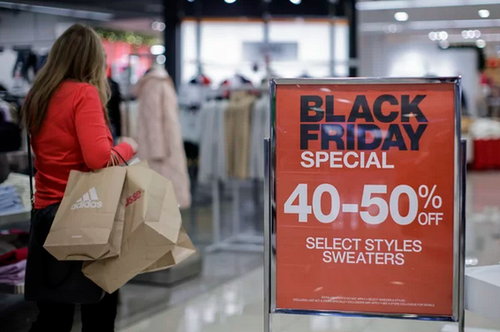
Deeper than expected Black Friday discounts have shifted the focus to profit margins, adding insult to injury to a sector that was already headed into year-end as one of the worst-performers in the S&P 500, with companies such as Target and Best Buy having shocked investors by slashing forecasts in recent weeks.
To be sure there was some good news: while the traditional Black Friday scenes of shoppers trampling each other for flatscreen TVs and Playstations were nowhere to be found, online sales set a new record at $9 billion (up from $8.92 billion last year, and $9.03 billion in 2020) due to deeply discounted items ranging from apparel to electronics.
In a nutshell, in-store sales were nothing special, online sales were outstanding, but deep inventory-liquidating discounts - the kind we warned about back in May when discussing the reverse bullwhip effect - aimed at stimulating spending have raised analyst concerns about margins.
As far as in-store traffic goes, Goldman made the following observations in the Northeast, Texas and Utah;
- Overall traffic still appeared muted relative to 2019 at most "traditional" Black Friday weekend destinations, but was still higher than 2021.
- Consumer electronics, toys, and sporting goods had the most traffic.
- Promotions are back, as expected.
- Stores looked very well stocked (which again is no surprise, see our preview more than six months ago about the 'reverse-bullwhip' effect leading to an oversupply of inventory which retailers have struggled to pare down).
Goldman further notes that according to Shopify data released Sunday there was a 19% increase in Black Friday sales vs. 2021, with the best performing categories being apparel & accessories, health & beauty, and home & garden.
The online sales blowout vs. muted in-store traffic comports with what we noted yesterday, as major shopping centers saw light activity despite the discounts.
Black Friday Has Gotten Out Of Control pic.twitter.com/AzhL3rFnas
— Steve Inman (@SteveInmanUIC) November 26, 2022
As the Financial Times notes:
The retail industry expects weaker growth over the course of the peak shopping season, with the National Retail Federation forecasting sales will advance 6-8 per cent during November and December. That would barely keep pace with inflation, which was running at 7.7 per cent in October.
As noted above, online sales set a record on Friday - with retailers such as Urban Outfitters observing that shoppers were putting record amounts of goods in their online shopping carts.The biggest discounts this year were for toys, which averaged 34% off listed prices, while electronics saw discounts peak at 27% according to Friday figures released by Adobe Analytics. Goldman also noted that online promotional activity began earlier in the week, with retailers using various promotional tactics - including targeted discounts and free shipping - to move products.
That said, it now appears that Black Friday discounts were so deep that some analysts have expressed concern over margins. Here is a snapshot of sellside takes from the start to holiday spending:
- Jeffries' Rondal Konik notes that a record number of companies offered higher promotions compared to last year.
- Morgan Stanley's Alex Straton says Black Friday traffic appeared "mixed," and "sees further margin risk if consumers hold out on spending and force retailers to offer deeper discounts."
- KeyBanc's Noah Zatkin says Black Friday weekend played out largely in-line with his expectations, with traffic 'solid, but not strong,' with in-store traffic for apparel and footwear brands softer relative to other categories. While Baird analyst Colin Sebastian said that online sales saw a solid weekend, and that significant discounting stimulated higher spending rates beginning early last week.
Companies to watch include Etsy, Wayfair, EBay, Chewy, Target, Costco and Best Buy, as well as sportswear brands such as Nike, Lululemon and Under Armour.
Now to see what Cyber Monday brings...
Deeper than expected Black Friday discounts have shifted the focus to profit margins, adding insult to injury to a sector that was already headed into year-end as one of the worst-performers in the S&P 500, with companies such as Target and Best Buy having shocked investors by slashing forecasts in recent weeks.
To be sure there was some good news: while the traditional Black Friday scenes of shoppers trampling each other for flatscreen TVs and Playstations were nowhere to be found, online sales set a new record at $9 billion (up from $8.92 billion last year, and $9.03 billion in 2020) due to deeply discounted items ranging from apparel to electronics.
In a nutshell, in-store sales were nothing special, online sales were outstanding, but deep inventory-liquidating discounts – the kind we warned about back in May when discussing the reverse bullwhip effect – aimed at stimulating spending have raised analyst concerns about margins.
As far as in-store traffic goes, Goldman made the following observations in the Northeast, Texas and Utah;
- Overall traffic still appeared muted relative to 2019 at most “traditional” Black Friday weekend destinations, but was still higher than 2021.
- Consumer electronics, toys, and sporting goods had the most traffic.
- Promotions are back, as expected.
- Stores looked very well stocked (which again is no surprise, see our preview more than six months ago about the ‘reverse-bullwhip‘ effect leading to an oversupply of inventory which retailers have struggled to pare down).
Goldman further notes that according to Shopify data released Sunday there was a 19% increase in Black Friday sales vs. 2021, with the best performing categories being apparel & accessories, health & beauty, and home & garden.
The online sales blowout vs. muted in-store traffic comports with what we noted yesterday, as major shopping centers saw light activity despite the discounts.
Black Friday Has Gotten Out Of Control pic.twitter.com/AzhL3rFnas
— Steve Inman (@SteveInmanUIC) November 26, 2022
As the Financial Times notes:
The retail industry expects weaker growth over the course of the peak shopping season, with the National Retail Federation forecasting sales will advance 6-8 per cent during November and December. That would barely keep pace with inflation, which was running at 7.7 per cent in October.
As noted above, online sales set a record on Friday – with retailers such as Urban Outfitters observing that shoppers were putting record amounts of goods in their online shopping carts.The biggest discounts this year were for toys, which averaged 34% off listed prices, while electronics saw discounts peak at 27% according to Friday figures released by Adobe Analytics. Goldman also noted that online promotional activity began earlier in the week, with retailers using various promotional tactics – including targeted discounts and free shipping – to move products.
That said, it now appears that Black Friday discounts were so deep that some analysts have expressed concern over margins. Here is a snapshot of sellside takes from the start to holiday spending:
- Jeffries‘ Rondal Konik notes that a record number of companies offered higher promotions compared to last year.
- Morgan Stanley‘s Alex Straton says Black Friday traffic appeared “mixed,” and “sees further margin risk if consumers hold out on spending and force retailers to offer deeper discounts.”
- KeyBanc‘s Noah Zatkin says Black Friday weekend played out largely in-line with his expectations, with traffic ‘solid, but not strong,’ with in-store traffic for apparel and footwear brands softer relative to other categories. While Baird analyst Colin Sebastian said that online sales saw a solid weekend, and that significant discounting stimulated higher spending rates beginning early last week.
Companies to watch include Etsy, Wayfair, EBay, Chewy, Target, Costco and Best Buy, as well as sportswear brands such as Nike, Lululemon and Under Armour.
Now to see what Cyber Monday brings…




